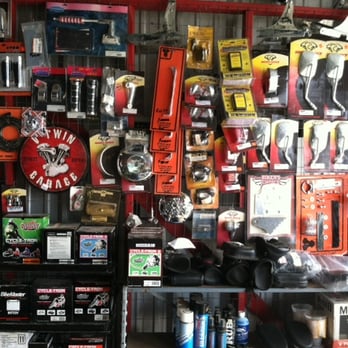Shop the very best MX Parts NZ for Your High-Performance Bike
Shop the very best MX Parts NZ for Your High-Performance Bike
Blog Article
Comprehending the Vital Parts of a Bike: A Comprehensive Overview for Enthusiasts
For motorcycle enthusiasts wanting to raise their riding experience and ensure their bikes run smoothly, understanding the important parts of a bike is extremely important. Each aspect, from the engine's elaborate functions to the crucial function of the braking devices, not just influences efficiency however likewise safety and security and comfort. This overview will go through the essential parts that every cyclist ought to recognize with, enabling notified choices in both upkeep and prospective upgrades. As we start this expedition, one must ask: how does each component engage to create the smooth experience every enthusiast looks for?
Engine Parts

The camshaft plays an essential function in controlling the timing of the engine's valves, ensuring the accurate opening and closing needed for efficient fuel and air intake, in addition to exhaust expulsion. This timing is essential to maintaining optimal engine efficiency and performance. Additionally, the carburetor or fuel injection system, depending on the motorbike version, is liable for blending air with fuel in the appropriate proportion for burning.
The cooling system, either air or liquid-based, functions to maintain the engine's temperature level within functional limits, stopping getting too hot and ensuring longevity - motocross parts nz. Each part, carefully developed and incorporated, adds to the seamless operation of the engine, specifying the bike's power outcome and general performance
Transmission System
Integral to the motorbike's performance, the transmission system guarantees reliable power transfer from the engine to the wheels. This system makes up numerous vital parts, consisting of the clutch, gearbox, and final drive, each playing a crucial role in equating the engine's power right into motion. The clutch, commonly run by a hand bar, serves to engage and disengage the engine from the transmission, allowing for smooth gear changes and controlled acceleration.
The gearbox, frequently referred to as the transmission correct, has a collection of gears that riders can manually shift through to adjust the bike's rate and torque output. These gears are prepared in a series that makes it possible for the motorcycle to increase efficiently and keep optimal engine performance across numerous rates. The majority of motorbikes utilize a sequential transmission, calling for the cyclist to change gears in a predetermined order.
Braking Mechanisms
While recognizing the transmission system is vital to using a bike's power, equally essential is the capability to manage and quit that power efficiently, which is where stopping devices come into play. Brakes are crucial for safety and efficiency, offering the biker with the needed control to navigate various surfaces and conditions. Generally, bikes feature two kinds of braking systems: disc brakes and drum brakes.
Disc brakes are extra widespread in contemporary motorbikes due to their premium performance. This system offers much better heat dissipation, regular efficiency, and improved quiting power, specifically in damp conditions.
Conversely, drum brakes, though less usual, are still located in some motorbikes. They function by pressing brake footwear against the inner surface of a drum connected to the wheel. While normally less effective in warm dissipation and stopping power, drum brakes are simpler and extra economical.
Recognizing these stopping systems' nuances allows bikers to preserve their motorbikes appropriately and value the engineering that ensures risk-free and effective quiting.
Suspension and Steering
Suspension and steering systems are important elements that considerably influence a bike's handling and adventure convenience. The suspension try here system, containing forks at the front and shock absorbers at the rear, absorbs roadway abnormalities, boosting security and control. Front forks, typically telescopic or upside down, compress and rebound to minimize influences, while rear shock absorbers preserve tire call with the road, important for traction and safety and security.
Steering, centered around the handlebars, connects the cyclist to the motorbike's directional control. The steering head bearings guarantee smooth procedure, permitting exact ability to move. Appropriate positioning and maintenance of these bearings are essential for top article predictable steering response and reducing motorcyclist fatigue.
The suspension's adjustability is one more important aspect; preload, damping, and rebound settings allow personalization to match numerous riding problems and styles. This flexibility is necessary for maximizing performance, whether navigating city roads or taking on sturdy tracks. Developments like digital suspension systems provide real-time modifications, improving adventure quality throughout varied terrains.

Electric Solutions
After making certain a controlled and smooth ride through reliable suspension and guiding systems, interest transforms to the electric systems, a pivotal element of modern motorbikes. These systems play a vital function not just in starting the engine yet also in powering different parts that boost the functionality and safety of the motorbike.
At the heart of a motorcycle's electrical system is the battery, which stores electric energy essential for starting the engine and powering complementary systems - motorcycle shop. The alternator or generator, coupled with the rectifier-regulator, makes certain the battery remains charged while the bike functions, converting mechanical energy into electrical energy and maintaining voltage levels
The ignition system, another critical element, is accountable for firing up the air-fuel mixture in the engine's cylinders. Modern motorcycles commonly utilize an electronic ignition system, supplying greater effectiveness and dependability compared to conventional systems.
Lighting systems, including headlights, tail lights, and indicators, are also crucial, ensuring visibility and safety and security for the biker. Added digital components such as sensors, control devices, and presents add to advanced features like fuel shot management, anti-lock stopping systems (ABS), and digital control panels, even more improving the riding experience.
Verdict
An extensive understanding of a motorbike's vital parts, including the engine, transmission system, stopping devices, suspension, guiding, and electric systems, is essential for fanatics aiming to maximize convenience, security, and efficiency. Mastery of these aspects enables notified choices pertaining to upkeep and upgrades, ultimately boosting the riding experience. By integrating this understanding, bikers can ensure their motorbikes operate at peak efficiency and integrity, consequently making the most of both satisfaction and longevity of their vehicles.
For motorcycle lovers looking to elevate their riding experience and guarantee their bikes run smoothly, recognizing the vital components of a bike is extremely important.Indispensable to the bike's functionality, the transmission system makes certain reliable power transfer from the engine to the wheels.While understanding the transmission system is essential to using a motorbike's power, equally crucial is the ability to manage and click here for info stop that power effectively, which is where stopping mechanisms come right into play. Commonly, motorcycles include two kinds of braking systems: disc brakes and drum brakes.
A detailed comprehension of a bike's vital components, including the engine, transmission system, stopping mechanisms, suspension, steering, and electrical systems, is indispensable for lovers aiming to enhance security, comfort, and efficiency.
Report this page